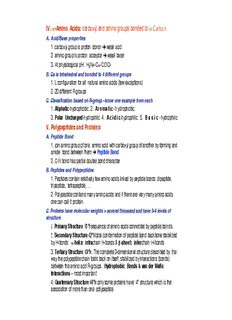
IV. -Amino Acids: carboxyl and amino groups bonded to -Carbon PDF
Preview IV. -Amino Acids: carboxyl and amino groups bonded to -Carbon
IV. -Amino Acids: carboxyl and amino groups bonded to -Carbon A. Acid/Base properties 1. carboxyl group is proton donor ! weak acid 2. amino group is proton acceptor ! weak base 3. At physiological pH: H N+-C -COO- 3 B. Ca is tetrahedral and bonded to 4 different groups 1. L configuration for all natural amino acids (few exceptions) 2. 20 different R groups C. Classification based on R-group - know one example from each 1. Aliphatic-hydrophobic 2. Aromatic-hydrophobic 3. Polar Uncharged-hydrophilic 4. Acidic-hydrophilic 5. B a s i c -hydrophilic V. Polypeptides and Proteins A. Peptide Bond 1. join amino group of one amino acid with carboxyl group of another by forming and amide bond between them ! Peptide Bond 2. C-N bond has partial double bond character B. Peptides and Polypeptides 1. Peptides contain relatively few amino acids linked by peptide bonds: dipeptide, tripeptide, tetrapeptide, …. 2. Polypeptide contains many amino acids and if there are very many amino acids one can call it protein C. Proteins have molecular weights > several thousand and have 3-4 levels of structure 1. Primary Structure (1°) sequence of amino acids connected by peptide bonds 2. Secondary Structure (2°) local conformation of peptide bond backbone stabilized by H-bonds: -helix: intrachain H-bonds & -sheet: interchain H-bonds 3. Tertiary Structure (3°): The complete 3-dimensional structure described by the way the polypeptide chain folds back on itself; stabilized by interactions (bonds) between the amino acid R-groups. Hydrophobic Bonds & van der Walls Interactions – most important 4. Quaternary Structure (4°): only some proteins have 4° structure which is the association of more than one polypeptide Complex Polymer Monomer Simple Polymer (Macromolecule) Monosaccharide Polysaccharide Oligosaccharide (Sugar) (Complex Carbohydrate) Nucleotide Oligonucleotide Nucleic Acid Polypeptide Amino Acid Peptid e Protein An Overview of Protein Functions Table 5.1 Describing Macromolecular Structure α carbon α-Amino Acids Amino group Carboxyl group At low pH pH ~7 at high pH H H H - H+ - H+ + O + O O H N C C H N C C H N C C 3 OH 3 O 2 O + H+ + H+ R R R +1 Charge 0 Charge -1 Charge Stereochemistry -- Tetrahedral α-Carbon L- D- Alanine Alanine O O O O C C α-Carbon N C C N C C 20 Different Amino Acids Are Found in Proteins 1-Letter Name 3-Letter 1-Letter Name 3-Letter A Alanine A M Methionine Met C Cysteine Cys N Asparagine Asn D Aspartic Acid Asp P Proline Pro E Glutamic Acid Glu Q Glutamine Gln F Phenylalanine Phe R Arginine Arg G Glycine G S Serine Set H Histidine H T Threonine Thr I Isoleucine Ile V Valine Val K Lysine Lys W Tryptophan Trp L Leucine Leu Y Tyrosine Tyr Fig. 5.16a: Non-polar, hydrophobic aliphatic and aromatic amino acids often cluster together and are found in the interior of proteins Nonpolar side chains; hydrophobic Side chain Glycine Alanine Valine Leucine Isoleucine (Gly or G) (Ala or A) (Val or V) (Leu or L) (Ile or I) Methionine Phenylalanine Tryptophan Proline (Met or M) (Phe or F) (Trp or W) (Pro or P) Polar uncharged side chains; hydrophilic Fig. 5.16b: Serine Threonine Cysteine (Ser or S) (Thr or T) (Cys or C) Tyrosine Asparagine Glutamine (Tyr or Y) (Asn or N) (Gln or Q) Fig. 5.16b: Amino Acids with Hydroxyl Groups in their Sidechains (S, T, Y) These amino acids can also be modified by phosphorylation (addition of phosphate to the hydroxyl group) - O - Side chain-O-P-O Side chain-O-H O
Description: